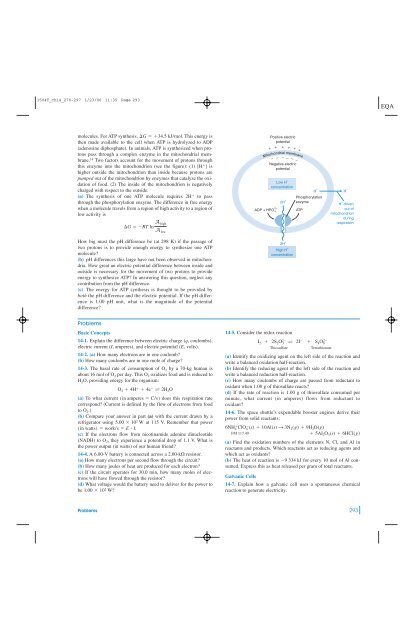Fundamentals of Electrochemistry - W.H. Freeman
Fundamentals of Electrochemistry - W.H. Freeman
Fundamentals of Electrochemistry - W.H. Freeman
Create successful ePaper yourself
Turn your PDF publications into a flip-book with our unique Google optimized e-Paper software.
1504T_ch14_270-297 1/23/06 11:35 Page 293<br />
molecules. For ATP synthesis, G 34.5 kJ/mol. This energy is<br />
then made available to the cell when ATP is hydrolyzed to ADP<br />
(adenosine diphosphate). In animals, ATP is synthesized when protons<br />
pass through a complex enzyme in the mitochondrial membrane.<br />
14 Two factors account for the movement <strong>of</strong> protons through<br />
this enzyme into the mitochondrion (see the figure): (1) [H ] is<br />
higher outside the mitochondrion than inside because protons are<br />
pumped out <strong>of</strong> the mitochondrion by enzymes that catalyze the oxidation<br />
<strong>of</strong> food. (2) The inside <strong>of</strong> the mitochondrion is negatively<br />
charged with respect to the outside.<br />
(a) The synthesis <strong>of</strong> one ATP molecule requires 2H to pass<br />
through the phosphorylation enzyme. The difference in free energy<br />
when a molecule travels from a region <strong>of</strong> high activity to a region <strong>of</strong><br />
low activity is<br />
A high<br />
G RT ln<br />
A low<br />
How big must the pH difference be (at 298 K) if the passage <strong>of</strong><br />
two protons is to provide enough energy to synthesize one ATP<br />
molecule?<br />
(b) pH differences this large have not been observed in mitochondria.<br />
How great an electric potential difference between inside and<br />
outside is necessary for the movement <strong>of</strong> two protons to provide<br />
energy to synthesize ATP? In answering this question, neglect any<br />
contribution from the pH difference.<br />
(c) The energy for ATP synthesis is thought to be provided by<br />
both the pH difference and the electric potential. If the pH difference<br />
is 1.00 pH unit, what is the magnitude <strong>of</strong> the potential<br />
difference?<br />
Positive electric<br />
potential<br />
+<br />
+<br />
–<br />
+<br />
Mitochondrial membrane<br />
–<br />
–<br />
Negative electric<br />
potential<br />
Low H +<br />
concentration<br />
ADP + HPO 2– 2H +<br />
2H +<br />
High H +<br />
concentration<br />
+<br />
+<br />
+<br />
–<br />
4<br />
ATP<br />
–<br />
–<br />
Phosphorylation<br />
enzyme<br />
H + H +<br />
H + driven<br />
out <strong>of</strong><br />
mitochondrion<br />
during<br />
respiration<br />
Problems<br />
Basic Concepts<br />
14-5. Consider the redox reaction<br />
14-1. Explain the difference between electric charge (q, coulombs),<br />
electric current (I, amperes), and electric potential (E, volts).<br />
Thiosulfate<br />
14-2. (a) How many electrons are in one coulomb?<br />
(b) How many coulombs are in one mole <strong>of</strong> charge?<br />
14-3. The basal rate <strong>of</strong> consumption <strong>of</strong> O 2 by a 70-kg human is<br />
about 16 mol <strong>of</strong> O 2 per day. This O 2 oxidizes food and is reduced to<br />
H 2 O, providing energy for the organism:<br />
O 2 4H 4e T 2H 2 O<br />
(a) To what current (in amperes C/s) does this respiration rate<br />
correspond? (Current is defined by the flow <strong>of</strong> electrons from food<br />
to O 2 .)<br />
(b) Compare your answer in part (a) with the current drawn by a<br />
refrigerator using 5.00 10 2 W at 115 V. Remember that power<br />
(in watts) work/s E I.<br />
(c) If the electrons flow from nicotinamide adenine dinucleotide<br />
(NADH) to O 2 , they experience a potential drop <strong>of</strong> 1.1 V. What is<br />
the power output (in watts) <strong>of</strong> our human friend?<br />
14-4. A 6.00-V battery is connected across a 2.00-k resistor.<br />
(a) How many electrons per second flow through the circuit?<br />
(b) How many joules <strong>of</strong> heat are produced for each electron?<br />
(c) If the circuit operates for 30.0 min, how many moles <strong>of</strong> electrons<br />
will have flowed through the resistor?<br />
(d) What voltage would the battery need to deliver for the power to<br />
be 1.00 10 2 W?<br />
I 2 2S 2 O 2 3<br />
T 2I S 4 O 2 6<br />
Tetrathionate<br />
(a) Identify the oxidizing agent on the left side <strong>of</strong> the reaction and<br />
write a balanced oxidation half-reaction.<br />
(b) Identify the reducing agent <strong>of</strong> the left side <strong>of</strong> the reaction and<br />
write a balanced reduction half-reaction.<br />
(c) How many coulombs <strong>of</strong> charge are passed from reductant to<br />
oxidant when 1.00 g <strong>of</strong> thiosulfate reacts?<br />
(d) If the rate <strong>of</strong> reaction is 1.00 g <strong>of</strong> thiosulfate consumed per<br />
minute, what current (in amperes) flows from reductant to<br />
oxidant?<br />
14-6. The space shuttle’s expendable booster engines derive their<br />
power from solid reactants:<br />
6NH4 ClO 4 (s) 10Al(s) S 3N 2 (g) 9H 2 O(g)<br />
FM 117.49<br />
5Al 2 O 3 (s) 6HCl(g)<br />
(a) Find the oxidation numbers <strong>of</strong> the elements N, Cl, and Al in<br />
reactants and products. Which reactants act as reducing agents and<br />
which act as oxidants?<br />
(b) The heat <strong>of</strong> reaction is 9 334 kJ for every 10 mol <strong>of</strong> Al consumed.<br />
Express this as heat released per gram <strong>of</strong> total reactants.<br />
Galvanic Cells<br />
14-7. Explain how a galvanic cell uses a spontaneous chemical<br />
reaction to generate electricity.<br />
Problems 293

















